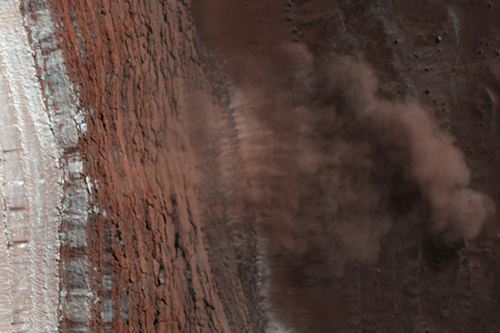Over the last month or so I’ve been slowly re-reading Kim Stanley Robinson’s epic Mars trilogy; I’m a little way into the second book (Green Mars), but my head is still full of the magnificent world-building that Robinson manages in the first installment, Red Mars. Also, oddly enough, I’ve been fascinated by the way that the way that the plotting in Red Mars – which uses flash-forwards, flashbacks and other jumps – is similar to the way the TV series Lost works. There are parallels, too, between the First Hundred (the first human colonists on Mars) and the survivors of Oceanic 815 (in Lost) in terms of the way their lives are ruled by the geographic isolation and unexpected challenges of territories unknown.
More to the point, with the vivid descriptions of Mars conjured by Robinson freshly in mind, I was really struck by a report which highlighted the fact that the High Resolution Imaging Science Experiment (HiRISE) has managed to capture images of an avalanche taking place on the surface of Mars!
These images really do capture the imagination. Although Mars is often considered close to a dead planet, burnt out and inactive, looking at these amazing photos really does remind me that our closest planetary neighbour holds many mysteries and far from satisfying my desire to know more, these images tantalise the imagination, and make me wonder what other stories the dusty red planet has to tell. [Via io9]



I love the Mars trilogy, and it’s played a big role in a few of my friendships as well as my worldview. KSR’s writing is so amazingly detailed and multifaceted, and I love the strong streak of anarchism that runs through it.
A friend once pointed out, though, how incredibly technocratic his ideas are – basically, scientists are clever enough to fix the world, if only we give them the chance. I’m not entirely sure about this, but it does seem to be a legitimate reading of his work. What do you think?
Hey Sky! Well, I certainly agree that scientists are at the core of KSR’s ideal of who could build/envision better worlds, but given the diversity of scientists in the First Hundred and beyond, I guess I’m more inclined to think that in the trilogy scientists are representative of the diversity of humanity at large.
The range of ideas from Hiroko to Arkady to Phyllis Boyle to Frank Chalmers to John Boone (reds, greens, Bogdanovists, areophanists …) are hugely diverse, playing out the tensions between existing nation-states (Chalmers as ‘US’, Maya as Russia), uber-capitalism (Phyllis and her UN-cum-transnation megacorp), radical environmentalism which sees the planet itself as the ideal (Reds), Mars as a separatist movement (Bogdanovists) and Hiroko’s areophany which seems to be a model in which planets and people must co-evolve to find a new equilibrium. I’d think that in that diversity, KSR is suggesting that scientists are focal points representing ideas and philosophies from across the spectrum of human ideas. Besides which, the scientists change their minds at times (eg Sax) while others cause radical problems while pursuing science per se (such as the impact of the longevity treatments – which make sense of Mars – on the already overpopulated Earth). So, I guess I’d be hesitant to call the book technocratic or even scientist-centric except insomuch as the scientists are representative of the range of human ideas, politics and philosophy.